Page 298 of 414
The maximum allowable weight of
the vehicle, all occupants, all
accessories, all cargo, and the
tongue load is:
To achieve a proper tongue load,
start by loading 60% of the load
toward the front of the trailer and
40% toward the rear, then re-adjust
the load as needed.
Theweightthatthe
tongue of a f ully-loaded trailer puts
on the hitch should be approximately
10% of the total trailer weight. Too
much tongue load reduces f ront-tire
traction and steering control. Too
little tongue load can make the
trailer unstable and cause it to sway.
CONT INUED
EX and EX-L:
V6 models:
EX and EX-L:
V6 models:
LX and LX-P:
LX and LX-P:
Towing a Trailer
Gross Vehicle Weight Rating
(GVWR):
Tongue Load:
U.S. models
Canadian models
Driving
295
4,575 lbs (2,075 kg)
4,431 lbs (2,010 kg)
4,299 lbs (1,950 kg)
1,970 kg
2,030 kg
2,090 kg
�����—�����—�
���y�
������
��
���y���
�)�����������y���������y
2010 Accord Sedan
Page 299 of 414
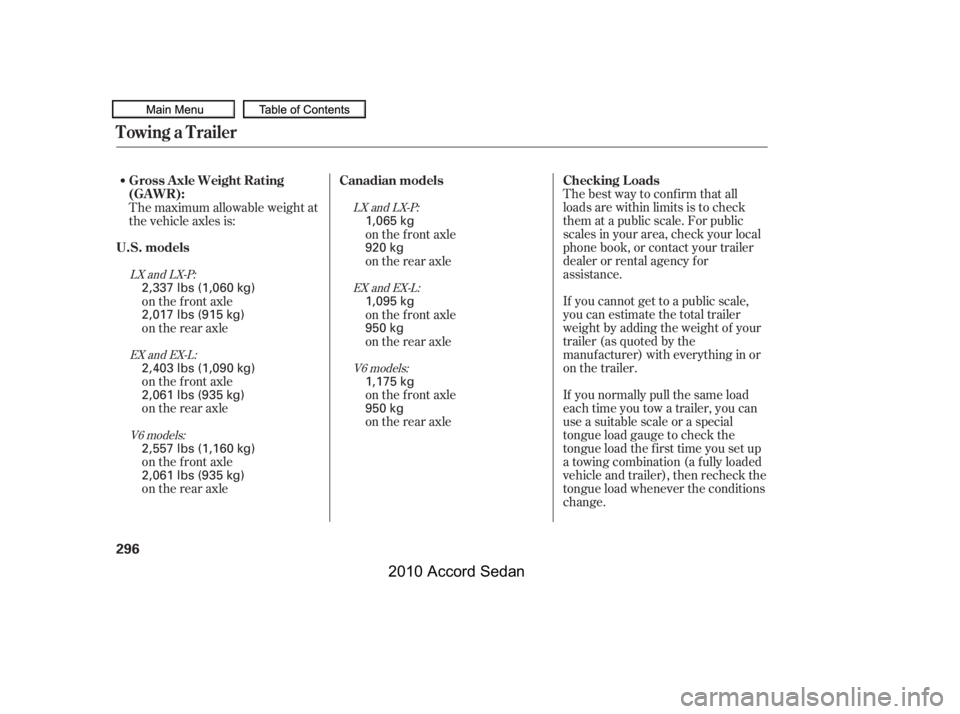
Thebestwaytoconfirmthatall
loads are within limits is to check
them at a public scale. For public
scales in your area, check your local
phone book, or contact your trailer
dealer or rental agency for
assistance.
If you cannot get to a public scale,
you can estimate the total trailer
weight by adding the weight of your
trailer (as quoted by the
manuf acturer) with everything in or
on the trailer.
If you normally pull the same load
each time you tow a trailer, you can
use a suitable scale or a special
tongue load gauge to check the
tongue load the f irst time you set up
a towing combination (a f ully loaded
vehicle and trailer), then recheck the
tongue load whenever the conditions
change.
The maximum allowable weight at
the vehicle axles is:
on the f ront axle
on the rear axle
on the f ront axle
on the rear axle
on the f ront axle
on the rear axle
on the f ront axle
on the rear axle
on the rear axle
on the f ront axle
on the rear axle
on the f ront axle
EX and EX-L:
V6 models:
EX and EX-L:
V6 models:
LX and LX-P:
LX and LX-P:
Towing a Trailer
Checking L oadsGross Axle Weight Rating
(GA WR):
Canadian models
U.S. models
296
2,017 lbs (915 kg)
2,337 lbs (1,060 kg)
2,403 lbs (1,090 kg)
2,061 lbs (935 kg)
2,557 lbs (1,160 kg)
2,061 lbs (935 kg)
920 kg
950 kg
950 kg
1,065 kg
1,095 kg
1,175 kg
�����—�����—�
���y�
������
������y���
�)�����������y�������
�y
2010 Accord Sedan
Page 300 of 414
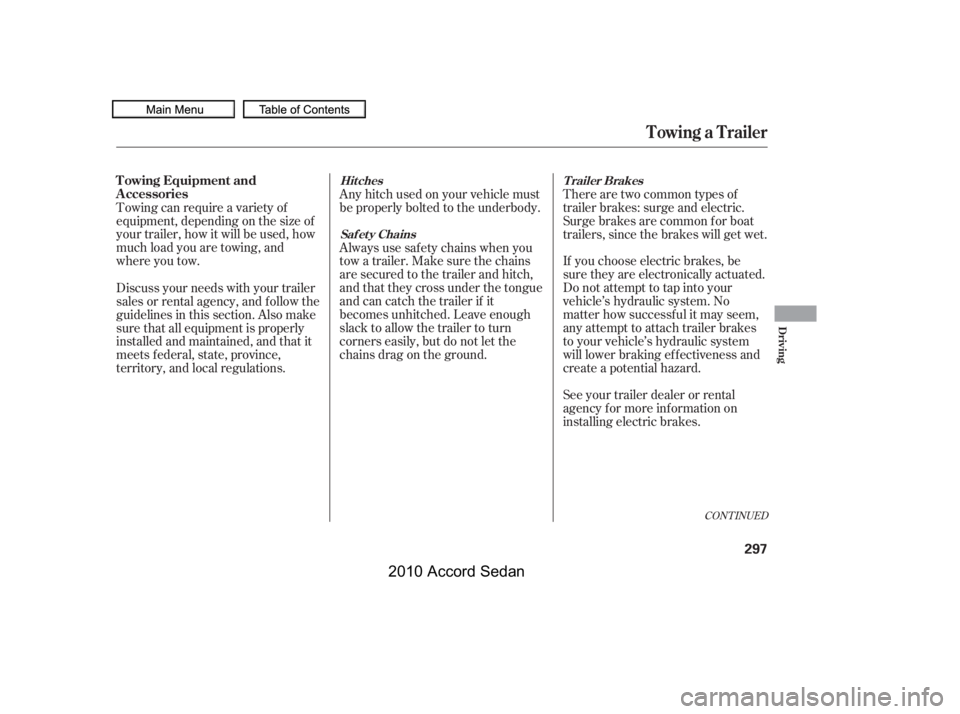
If you choose electric brakes, be
sure they are electronically actuated.
Do not attempt to tap into your
vehicle’s hydraulic system. No
matter how successf ul it may seem,
any attempt to attach trailer brakes
to your vehicle’s hydraulic system
will lower braking ef f ectiveness and
create a potential hazard.
Seeyourtrailerdealerorrental
agency f or more inf ormation on
installing electric brakes.
Towing can require a variety of
equipment, depending on the size of
your trailer, how it will be used, how
much load you are towing, and
where you tow.
Any hitch used on your vehicle must
be properly bolted to the underbody.
Always use saf ety chains when you
tow a trailer. Make sure the chains
are secured to the trailer and hitch,
and that they cross under the tongue
and can catch the trailer if it
becomes unhitched. Leave enough
slack to allow the trailer to turn
corners easily, but do not let the
chains drag on the ground.
Discuss your needs with your trailer
sales or rental agency, and f ollow the
guidelines in this section. Also make
sure that all equipment is properly
installed and maintained, and that it
meets f ederal, state, province,
territory, and local regulations.
There are two common types of
trailer brakes: surge and electric.
Surge brakes are common f or boat
trailers, since the brakes will get wet.
CONT INUED
Towing a Trailer
Trailer BrakesHitches
Saf et y Chains
T owing Equipment and
A ccessories
Driving
297
�����—�����—�
���y�
������
������y���
�)�����������y���������y
2010 Accord Sedan
Page 301 of 414
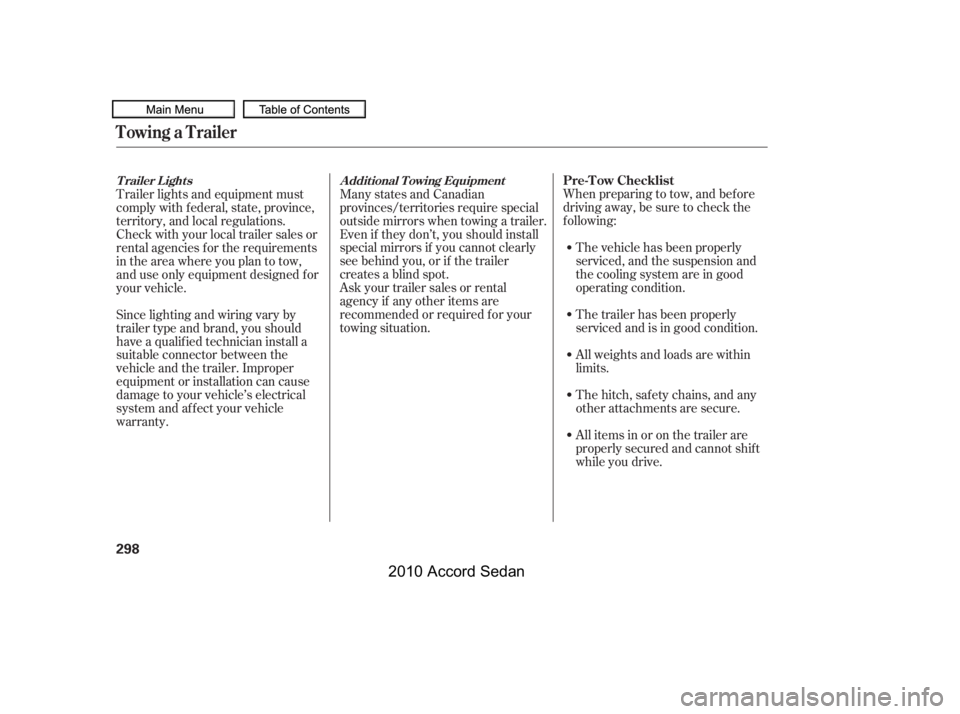
When preparing to tow, and bef ore
driving away, be sure to check the
f ollowing:
The vehicle has been properly
serviced, and the suspension and
the cooling system are in good
operating condition.
The trailer has been properly
serviced and is in good condition.
All weights and loads are within
limits.
Thehitch,safetychains,andany
other attachments are secure.
All items in or on the trailer are
properly secured and cannot shif t
while you drive.
Many states and Canadian
provinces/territories require special
outside mirrors when towing a trailer.
Even if they don’t, you should install
special mirrors if you cannot clearly
see behind you, or if the trailer
creates a blind spot.
Askyourtrailersalesorrental
agency if any other items are
recommended or required f or your
towing situation.
Trailer lights and equipment must
comply with f ederal, state, province,
territory, and local regulations.
Check with your local trailer sales or
rental agencies f or the requirements
in the area where you plan to tow,
and use only equipment designed f or
your vehicle.
Since lighting and wiring vary by
trailer type and brand, you should
have a qualif ied technician install a
suitable connector between the
vehicle and the trailer. Improper
equipment or installation can cause
damage to your vehicle’s electrical
system and af f ect your vehicle
warranty.
Towing a Trailer
Pre-T ow ChecklistA ddit ional T owing EquipmentT railer L ights
298
�����—�����—�
���y�
������
������y���
�)�����������y���������y
2010 Accord Sedan
Page 302 of 414
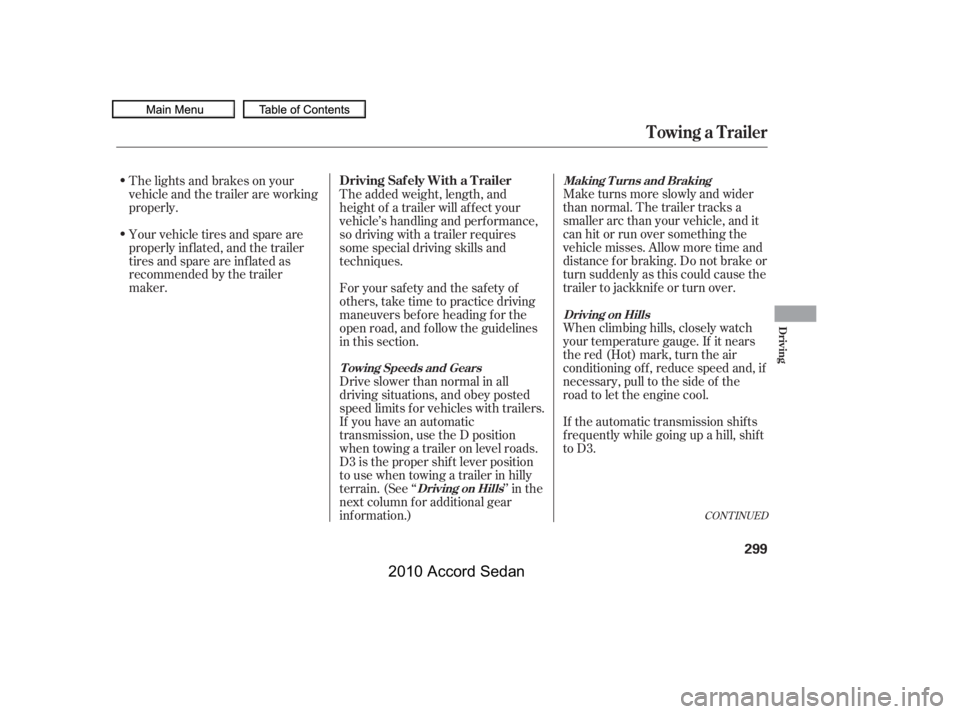
Maketurnsmoreslowlyandwider
than normal. The trailer tracks a
smaller arc than your vehicle, and it
canhitorrunoversomethingthe
vehicle misses. Allow more time and
distance f or braking. Do not brake or
turn suddenly as this could cause the
trailer to jackknif e or turn over.
When climbing hills, closely watch
your temperature gauge. If it nears
the red (Hot) mark, turn the air
conditioning of f , reduce speed and, if
necessary, pull to the side of the
road to let the engine cool.
If the automatic transmission shif ts
f requently while going up a hill, shif t
to D3.
The lights and brakes on your
vehicle and the trailer are working
properly.
Your vehicle tires and spare are
properly inf lated, and the trailer
tires and spare are inflated as
recommended by the trailer
maker.
The added weight, length, and
height of a trailer will af f ect your
vehicle’s handling and perf ormance,
so driving with a trailer requires
some special driving skills and
techniques.
Foryoursafetyandthesafetyof
others,taketimetopracticedriving
maneuvers bef ore heading f or the
open road, and f ollow the guidelines
in this section.
Drive slower than normal in all
driving situations, and obey posted
speed limits f or vehicles with trailers.
If you have an automatic
transmission, use the D position
when towing a trailer on level roads.
D3 is the proper shif t lever position
to use when towing a trailer in hilly
terrain. (See ‘‘’’ in the
next column f or additional gear
inf ormation.)CONT INUED
Making T urns and Braking
Driving on Hills
T owing Speeds and Gears
Driving on Hills
Towing a Trailer
Driving Saf ely With a T railer
Driving
299
�����—�����—�
���y�
�������������y���
�)�����������y���������y
2010 Accord Sedan
Page 303 of 414
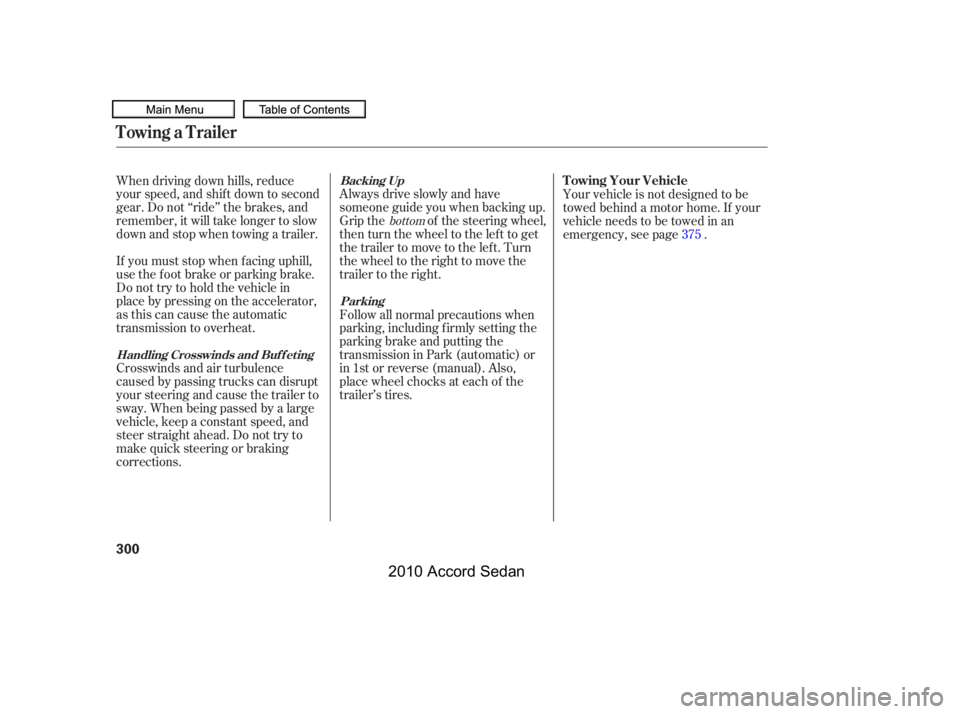
Always drive slowly and have
someone guide you when backing up.
Grip the of the steering wheel,
then turn the wheel to the left to get
the trailer to move to the lef t. Turn
the wheel to the right to move the
trailer to the right.
When driving down hills, reduce
your speed, and shif t down to second
gear. Do not ‘‘ride’’ the brakes, and
remember, it will take longer to slow
downandstopwhentowingatrailer.
If you must stop when f acing uphill,
use the f oot brake or parking brake.
Do not try to hold the vehicle in
placebypressingontheaccelerator,
as this can cause the automatic
transmission to overheat.
Your vehicle is not designed to be
towed behind a motor home. If your
vehicle needs to be towed in an
emergency, see page .
Crosswinds and air turbulence
caused by passing trucks can disrupt
your steering and cause the trailer to
sway. When being passed by a large
vehicle, keep a constant speed, and
steer straight ahead. Do not try to
make quick steering or braking
corrections.
Follow all normal precautions when
parking, including f irmly setting the
parking brake and putting the
transmission in Park (automatic) or
in 1st or reverse (manual). Also,
place wheel chocks at each of the
trailer’s tires.
375
bottom
Backing Up
Parking
Handling Crosswinds and Buf f et ing
Towing Your Vehicle
Towing a Trailer
300
�����—�����—�
���y�
���������
���y���
�)�����������y���������y
2010 Accord Sedan
Page 327 of 414

�µ�µ
The timing belt should be replaced
according to the maintenance
minder (see page ).
Replace the timing belt every 60,000
miles (U.S.) or every 100,000 km
(Canada) if you regularly drive your
vehicle in any of the f ollowing
conditions:
Always use Honda Power Steering
Fluid. You may use another power
steering f luid as an emergency
replacement, but have the power
steering system f lushed and ref illed
with Honda PSF as soon as possible.
A low power steering f luid level can
indicate a leak in the system. Check
the f luid level f requently, and have
the system inspected as soon as
possible.
In very high temperatures
(over 110°F, 43°C).
In very low temperatures
(under 20°F, 29°C).
Pour the f luid slowly and caref ully
so you do not spill any. Clean up
any spills immediately; it could
damage components in the engine
compartment.
If you f requently tow a trailer.
303
V6 models
Timing Belt
Power Steering Fluid, Timing Belt
324
UPPER LEVEL
LOWER LEVELV6 models
Turning the steering wheel to f ull lef t
or right lock and holding it there can
damage the power steering pump.
�����—�����—�
���y�
���������
���y���
�)�����������y���������y
2010 Accord Sedan
Page 328 of 414
Theheadlightswereproperlyaimed
when your vehicle was new. If you
regularly carry heavy items in the
trunk or pull a trailer, readjustment
may be required. Adjustments
should be done by your dealer or
another qualif ied technician.
Your vehicle has halogen headlight
bulbs. When replacing a bulb, handle
it by its base, and protect the glass
f rom contact with your skin or hard
objects. If you touch the glass, clean
it with denatured alcohol and a clean
cloth.
Open the hood.
To change a bulb on the
passenger’s side, remove the
engine coolant reserve tank by
pulling it out of its stay.
1.
CONT INUED
Headlight A imingReplacing a Headlight Bulb
Lights
High Beam Headlight
Maint enance
325
STAY4-cylinder models
Halogen headlight bulbs get very hot
when lit. Oil, perspiration, or a scratch
on the glass can cause the bulb to
overheat and shatter.
�����—�����—�
���y�
�������������y���
�)�����������y���������y
2010 Accord Sedan